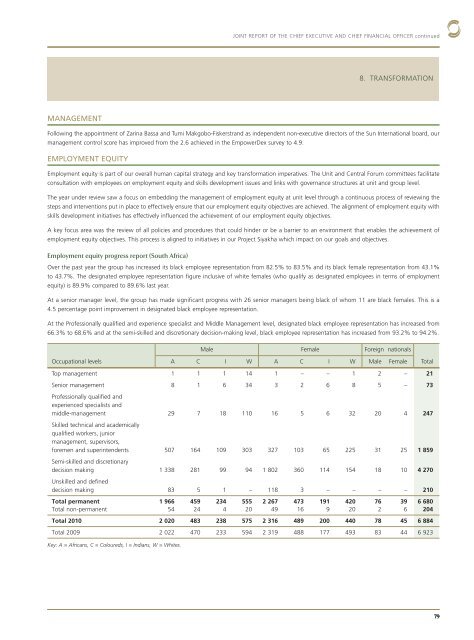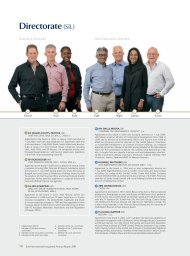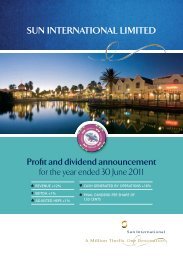PDF 25 MB - Sun International | Investor Centre
PDF 25 MB - Sun International | Investor Centre
PDF 25 MB - Sun International | Investor Centre
You also want an ePaper? Increase the reach of your titles
YUMPU automatically turns print PDFs into web optimized ePapers that Google loves.
MANAGEMENT<br />
JOINT REPORT OF THE CHIEF EXECUTIVE AND CHIEF FINANCIAL OFFICER continued<br />
Following the appointment of Zarina Bassa and Tumi Makgobo-Fiskerstrand as independent non-executive directors of the <strong>Sun</strong> <strong>International</strong> board, our<br />
management control score has improved from the 2.6 achieved in the EmpowerDex survey to 4.9.<br />
EMPLOYMENT EQUITY<br />
Employment equity is part of our overall human capital strategy and key transformation imperatives. The Unit and Central Forum committees facilitate<br />
consultation with employees on employment equity and skills development issues and links with governance structures at unit and group level.<br />
The year under review saw a focus on embedding the management of employment equity at unit level through a continuous process of reviewing the<br />
steps and interventions put in place to effectively ensure that our employment equity objectives are achieved. The alignment of employment equity with<br />
skills development initiatives has effectively influenced the achievement of our employment equity objectives.<br />
A key focus area was the review of all policies and procedures that could hinder or be a barrier to an environment that enables the achievement of<br />
employment equity objectives. This process is aligned to initiatives in our Project Siyakha which impact on our goals and objectives.<br />
Employment equity progress report (South Africa)<br />
Over the past year the group has increased its black employee representation from 82.5% to 83.5% and its black female representation from 43.1%<br />
to 43.7%. The designated employee representation figure inclusive of white females (who qualify as designated employees in terms of employment<br />
equity) is 89.9% compared to 89.6% last year.<br />
At a senior manager level, the group has made significant progress with 26 senior managers being black of whom 11 are black females. This is a<br />
4.5 percentage point improvement in designated black employee representation.<br />
At the Professionally qualified and experience specialist and Middle Management level, designated black employee representation has increased from<br />
66.3% to 68.6% and at the semi-skilled and discretionary decision-making level, black employee representation has increased from 93.2% to 94.2%.<br />
Occupational levels<br />
Male Female Foreign nationals<br />
A C I W A C I W Male Female Total<br />
Top management 1 1 1 14 1 – – 1 2 – 21<br />
Senior management 8 1 6 34 3 2 6 8 5 – 73<br />
Professionally qualified and<br />
experienced specialists and<br />
middle-management 29 7 18 110 16 5 6 32 20 4 247<br />
Skilled technical and academically<br />
qualified workers, junior<br />
management, supervisors,<br />
foremen and superintendents 507 164 109 303 327 103 65 2<strong>25</strong> 31 <strong>25</strong> 1 859<br />
Semi-skilled and discretionary<br />
decision making 1 338 281 99 94 1 802 360 114 154 18 10 4 270<br />
Unskilled and defined<br />
decision making 83 5 1 – 118 3 – – – – 210<br />
Total permanent 1 966 459 234 555 2 267 473 191 420 76 39 6 680<br />
Total non-permanent 54 24 4 20 49 16 9 20 2 6 204<br />
Total 2010 2 020 483 238 575 2 316 489 200 440 78 45 6 884<br />
Total 2009 2 022 470 233 594 2 319 488 177 493 83 44 6 923<br />
Key: A = Africans, C = Coloureds, I = Indians, W = Whites.<br />
8. TRANSFORMATION<br />
79<br />
79










